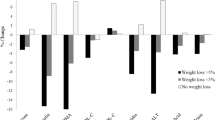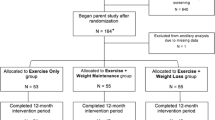Abstract
The causes of weight loss in Huntington’s disease (HD) are not entirely clear. The aim was to identify risk factors that are associated with a loss of metabolically active tissues, i.e. fat-free mass. A consecutive cohort of non-diabetic HD participants (manifest HD, n = 43; CAG: mean 43.6.0 ± 3.6; preHD, n = 10; CAG: mean 41.4 ± 1.4) and 36 healthy controls was recruited. Twenty-five HD participants were early-stage HD (UHDRS Total Functional Capacity [TFC] stages I and II), 12 mid-stage HD (TFC stage III), and 6 participants were in late-stage HD (TFC stages IV and V). Food intake, basic metabolic rate and glucose homeostasis were assessed. In addition, fat-free mass was determined using bioelectric impedance analysis, and leptin, insulin and ghrelin as key metabolic regulators. Sex ratio and age were similar in HD participants (71 % women; age 50.6 ± 10.9) and controls (66 % women; age 46.4 ± 14.5). Body mass index (BMI) was lower in HD participants than controls (median 24.1 vs. 25.9, p = 0.04). However, fat-free mass and basic metabolic rate were not statistically different between groups and showed no association with disease burden. In controls and HD participants, leptin was the most important predictor of fat-free mass. While BMI was lower in HD participants, fat-free mass was similar to controls with leptin as its most important predictor. Leptin levels and fat-free mass measurements using bioelectric impedance analysis may be good screening tools to identify HD patients at risk for weight loss.



Similar content being viewed by others
References
Ross CA, Tabrizi SJ (2011) Huntington’s disease: from molecular pathogenesis to clinical treatment. Lancet Neurol 10:83–98
van der Burg JM, Bjorkqvist M, Brundin P (2009) Beyond the brain: widespread pathology in Huntington’s disease. Lancet Neurol 8:765–774
Bruyn GW, Went LN (1986) Huntington’s chorea. In: Vinken PJ, Bruyn GW, Klawans HL (eds) Handbook of Clinical Neurology 2. Elsevier, Amsterdam, pp 267–313
Greenamyre JT, Shoulson I (1994) Huntington’s disease. In: Calne DB (ed) Neurodegenerative diseases. WB Saunders, Philadelphia, pp 685–704
Aziz NA, van der Burg JM, Landwehrmeyer GB et al (2008) Weight loss in Huntington disease increases with higher CAG repeat number. Neurology 71:1506–1513
Djousse L, Knowlton B, Cupples LA et al (2002) Weight loss in early stage of Huntington’s disease. Neurology 59:1325–1330
Mochel F, Charles P, Seguin F et al (2007) Early energy deficit in Huntington disease: identification of a plasma biomarker traceable during disease progression. PLoS One 2:e647
Van Raamsdonk JM, Gibson WT, Pearson J et al (2006) Body weight is modulated by levels of full-length huntingtin. Hum Mol Genet 15:1513–1523
Gray M, Shirasaki DI, Cepeda C et al (2008) Full-length human mutant huntingtin with a stable polyglutamine repeat can elicit progressive and selective neuropathogenesis in BACHD mice. J Neurosci 28:6182–6195
Hult S, Soylu R, Bjorklund T, Belgardt BF et al (2011) Mutant huntingtin causes metabolic imbalance by disruption of hypothalamic neurocircuits. Cell Metab 13:428–439
Myers RH, Sax DS, Koroshetz WJ et al (1991) Factors associated with slow progression in Huntington’s disease. Arch Neurol 48:800–804
Huntington Study Group (1996) Unified Huntington’s disease rating scale: reliability and consistency. Mov Disord 11:136–142
Haufe S, Engeli S, Budziarek P et al (2010) Cardiorespiratory fitness and insulin sensitivity in overweight or obese subjects may be linked through intrahepatic lipid content. Diabetes 59:1640–1647
Matsuda M, DeFronzo RA (1999) Insulin sensitivity indices obtained from oral glucose tolerance testing: comparison with the euglycemic insulin clamp. Diabetes Care 22:1462–1470
Sieber CC (2006) Nutritional screening tools—How does the MNA compare? Proceedings of the session held in Chicago May 2–3, (15 years of Mini Nutritional Assessment). J Nutr Health Aging 10:488–492
Harris JA, Benedict FG (1918) A biometric study of human basal metabolism. Proc Natl Acad Sci USA 4:370–373
Kyle UG, Genton L, Karsegard L et al (2001) Single prediction equation for bioelectrical impedance analysis in adults aged 20–94 years. Nutr 17:248–253
Therneau TM, Atkinson EJ (1997) An introduction to recursive partitioning using the rpart routine. Technical Report 61, Section of Biostatistics Mayo Clinic, Rochester. http://www.mayo.edu/research/departments-divisions/department-health-sciences-research/division-biomedical-statistics-informatics/technical-reports
Breiman L (2003) Manual on setting up, using, and understanding random forests V4.0. http://www.stat.berkeley.edu/~breiman/papers.html
Penney JB Jr, Vonsattel JP, MacDonald ME et al (1997) CAG repeat number governs the development rate of pathology in Huntington’s disease. Ann Neurol 41:689–692
Sanberg PR, Fibiger HC, Mark RF (1981) Body weight and dietary factors in Huntington’s disease patients compared with matched controls. Med J Aust 1:407–409
Farrer LA, Meaney FJ (1985) An anthropometric assessment of Huntington’s disease patients and families. Am J Phys Anthropol 67:185–194
Pratley RE, Salbe AD, Ravussin E, Caviness JN (2000) Higher sedentary energy expenditure in patients with Huntington’s disease. Ann Neurol 47:64–70
Hamilton JM, Wolfson T, Peavy GM et al (2004) Rate and correlates of weight change in Huntington’s disease. J Neurol Neurosurg Psychiatry 75:209–212
Robbins AO, Ho AK, Barker RA (2006) Weight changes in Huntington’s disease. Eur J Neurol 13:e7
Sassone J, Colciago C, Cislaghi G et al (2009) Huntington`s disease: the current state of research with peripheral tissues. Exp Neurol 219:385–397
Busse ME, Hughes G, Wiles CM et al (2008) Use of hand-held dynamometry in the evaluation of lower limb muscle strength in people with Huntington`s disease. J Neurol 255:1534–1540
Stüwe SH, Goetze O, Lukas C et al (2013) Hepatic mitochondrial dysfunction in manifest and premanifest Huntington´s Disease. Neurology 80:743–746
Scherer PE (2006) Adipose tissue: from lipid storage compartment to endocrine organ. Diabetes 55:1537–1545
Phan J, Hickey MA, Zhang P et al (2009) Adipose tissue dysfunction tracks disease progression in two Huntington’s disease mouse models. Hum Mol Genet 18:1006–1016
Berglund J, Johansson L, Ahlstrom H et al (2010) Three-point Dixon method enables whole-body water and fat imaging of obese subjects. Magn Reson Med Off J Soc Magn Reson Med/Soc Magn Reson Med 63:1659–1668
Klok MD, Jakobsdottir S, Drent ML (2007) The role of leptin and ghrelin in the regulation of food intake and body weight in humans: a review. Obes Rev 8:21–34
Jequier E, Tappy L (1999) Regulation of body weight in humans. Physiol Rev 79:451–480
Aziz NA, Pijl H, Frölich M et al (2010) Leptin secretion rate increases with higher CAG repeat number in Huntington`s disease patients. Clin Endocrinol 73:206–211
Russo CV, Salvatore E, Sacca F et al (2013) Insulin sensitivity and early-phase insulin secretion in normoglycemic Huntington’s disease patients. J Huntingtons Dis 2:501–507
Lalic NM, Maric J, Svetel M et al (2008) Glucose homeostasis in Huntington disease: abnormalities in insulin sensitivity and early-phase insulin secretion. Arch Neurol 65:476–480
Bjorkqvist M, Fex M, Renstrom E et al (2005) The R6/2 transgenic mouse model of Huntington’s disease develops diabetes due to deficient beta-cell mass and exocytosis. Hum Mol Genet 14:565–574
Marder K, Zhao H, Eberly S et al (2009) Dietary intake in adults at risk for Huntington disease: analysis of PHAROS research participants. Neurology 73:385–392
Smith J, Al-Amri M, Sniderman A et al (2006) Leptin and adiponectin in relation to body fat percentage, waist to hip ratio and the apoB/apoA1 ratio in Asian and Caucasian men and women. Nutr Metab 3:18
Acknowledgments
We thank all participants for their time and effort in supporting this study.
Conflicts of interest
GB Landwehrmeyer declares consultancies from: Bayer Pharma AG, CHDI, GlaxoSmithKline, Hoffmann-LaRoche, Ipsen, Neurosearch Inc, Medesis, Medtronic, Novartis, Pfizer, Prana Biotechnology, Sangamo/Shire, Siena Biotech and TEVA. Advisory Boards: Ipsen, Neurosearch Inc, Medivation, Pfizer, Siena Biotech and TEVA. Honoraria: AOP Orphan Pharmaceuticals AG, Temmler Pharma GmbH. Grants: CHDI Foundation, the Bundesministerium für Bildung und Forschung (BMBF), the Deutsche Forschungsgemeinschaft (DFG), the European Commission (EU-FP7). M Orth is in receipt of grants from CHDI Foundation and the European Commission (EU-FP7). The other authors report no conflict of interest.
Ethical standard
All procedures performed in studies involving human participants were in accordance with the ethical standards of the institutional research committee and with the 1964 Helsinki declaration and its later amendments or comparable ethical standards. This article does not contain any studies with animals performed by any of the authors.
Informed consent
Informed consent was obtained from all participants included in the study.
Author information
Authors and Affiliations
Corresponding author
Rights and permissions
About this article
Cite this article
Süssmuth, S.D., Müller, V.M., Geitner, C. et al. Fat-free mass and its predictors in Huntington’s disease. J Neurol 262, 1533–1540 (2015). https://doi.org/10.1007/s00415-015-7753-0
Received:
Revised:
Accepted:
Published:
Issue Date:
DOI: https://doi.org/10.1007/s00415-015-7753-0




